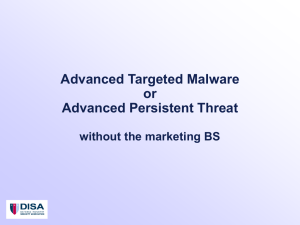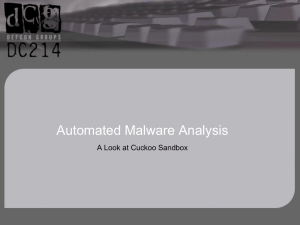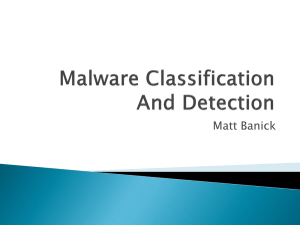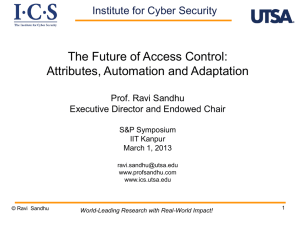Presentation - Prof. Ravi Sandhu
advertisement
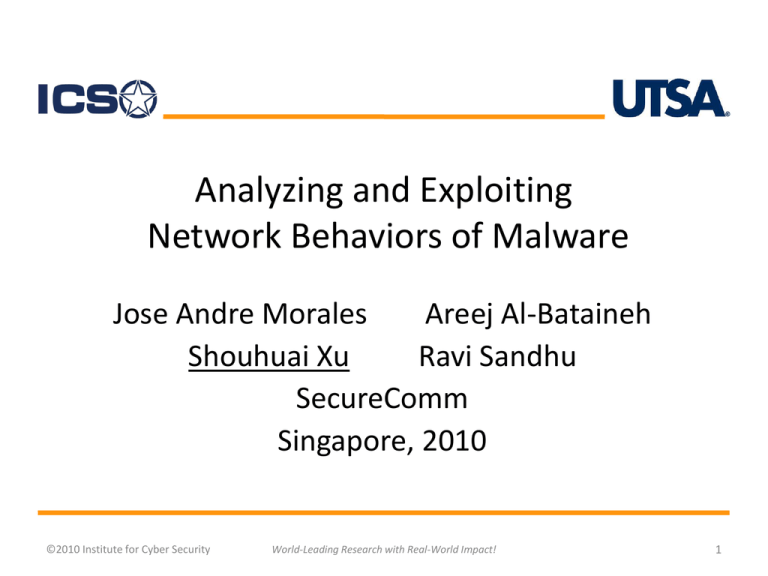
Analyzing and Exploiting Network Behaviors of Malware Jose Andre Morales Areej Al-Bataineh Shouhuai Xu Ravi Sandhu SecureComm Singapore, 2010 ©2010 Institute for Cyber Security World-Leading Research with Real-World Impact! 1 Introduction • Do malicious and benign processes behave differently from a networking perspective? • Can we exploit these differences to identify malware, especially zero-day attacks? • Analyzed 1000 malware samples, with 31 not detected by Virustotal.com 01 April 2010 and 123 benign samples • Focus on DNS, NetBIOS, TCP, UDP, ICMP ©2010 Institute for Cyber Security World-Leading Research with Real-World Impact! 2 Introduction - 2 • Log file analysis tallied various network event occurrence amounts • Along with traffic observations we identified behavior occurring mostly in malware • Defined 7 behaviors dealing with specific observed anomalies in network traffic • Some behaviors combine network events to form an anomaly • These behaviors used to differentiate between malicious and benign processes • Clustering and classification ©2010 Institute for Cyber Security World-Leading Research with Real-World Impact! 3 Contributions • Identification of network behaviors occurring mostly in malware usable in behavior based malware detection. • Discovery of novel malicious uses of network services by malware. • Evaluating the effectiveness of observed network behaviors in identifying malware and benign processes with clustering and classification. ©2010 Institute for Cyber Security World-Leading Research with Real-World Impact! 4 7 Behaviors • B1: Process performs a NetBIOS name request on a domain name that is not part of a DNS or rDNS query • B2: Failed connection attempt to an IP address obtained from a successful DNS query • B3: Failed connection attempt to the input IP address of a successful rDNS query • B4: Connection attempt to the input IP address of a failed rDNS query ©2010 Institute for Cyber Security World-Leading Research with Real-World Impact! 5 7 Behaviors • B5: ICMP only activity, ICMP echo requests for a specific non-local network IP address with no reply or a returned error message. • B6: TCP/ICMP activity, TCP connection attempts to non-local IP addresses that received a successful reply to their ICMP echo requests • B7: Network activity that is rarely occurring or implemented in an anomalous manner ©2010 Institute for Cyber Security World-Leading Research with Real-World Impact! 6 Behavior B1 • Process performs a NetBIOS name request on a domain name that is not part of a DNS or rDNS query • Table shows B1 occurring only in malware, benign NetBIOS used domain names previously used in a DNS query. • Several domains in B1 known malicious by Malwareurl.com but others were not ©2010 Institute for Cyber Security World-Leading Research with Real-World Impact! 7 Behaviors B2, B3 & B4 • DNS often used to acquire IP addresses • Only B2 occurred, many malware DNS domain names and cannot connect with returned IP, either offline or shutdown, or newly registered and inactive • B3, B4 no occurrence, possible less favored by malware authors ©2010 Institute for Cyber Security World-Leading Research with Real-World Impact! 8 Behaviors B5 & B6 • ICMP used by malware (like PING) to acquire active IP addresses, these IPs not part of previous DNS, rDNS or NetBIOS suspicious behavior. B6 dominant in malware • B5 almost same in both, very similar to DNS behavior with no request reply ©2010 Institute for Cyber Security World-Leading Research with Real-World Impact! 9 Behavior B7 • Considered suspicious but not necessarily malicious, behaviors were rarely occurring or implemented in non-conventional manner • TCP connection attemps most prevalent, IP not acquired via DNS, NetBios or ICMP, possibly hardwired or dynamically generated ©2010 Institute for Cyber Security World-Leading Research with Real-World Impact! 10 Behavior Evaluation • 1000 malware samples from CWSandbox 27 October 2009 upload, diverse set, still active durng testing. – 31 samples from 31 March 2010 upload not detected by Virustotal.com (MD5 search) 1 April 2010 • 41 benign samples executed 3 times each = 123 total benign samples – FTP, RSS, socnet, P2P, AV, net tools • Individual samples run for 10 minutes in VMWare (XP SP2) using Windows network monitor, proprietary netwok layer filters • Results revealed behaviors differentiate malicious from benign including 31 unidentified malware ©2010 Institute for Cyber Security World-Leading Research with Real-World Impact! 11 Clustering & Classification - 01 • Weka data mining software • Clustering used complete malware and benign data set • Classification training set used 1st 700 malware samples and 40 benign, testing used the remaining samples • 31 unknown samples not part of training set ©2010 Institute for Cyber Security World-Leading Research with Real-World Impact! 12 Clustering & Classification - 02 ©2010 Institute for Cyber Security World-Leading Research with Real-World Impact! 13 Clustering Results • If majority of cluster was malware then benign samples assumed FP, If majority of cluster was benign then malware samples assumed FN •Xmeans perfect, DBScan & EM encouraging •All 31 unknown malware correctly identified •FP video streamers known to be unreliable networks •EM FN mostly malware downloaders ©2010 Institute for Cyber Security World-Leading Research with Real-World Impact! 14 Classification Results • FN and FP very low, 2 malware flagged as FN by all 4, only 2 video streams flagged as FP • 29 unknown malware correctly identified by all 4 ©2010 Institute for Cyber Security World-Leading Research with Real-World Impact! 15 Discussion • B1, B2 & B7 most dominant behaviors • B1,B5 & B6 considered novel behaviors used by malware to find active remote hosts • Classification & clustering produced excellent results with minimal FN & FP • 31 malware not identified by virustotal.com on 1 April 2010 were correctly detected with minimal exceptions ©2010 Institute for Cyber Security World-Leading Research with Real-World Impact! 16 Conclusions • Network behaviors can be exploited to differentiate between malicious and benign • Discovered 3 novel network behaviors • Our approach can be combined with other perspectives to enrich detection accuracy • The behaviors detected a diverse set of malware inlcuding 31 unknown samples with minimal FP and FN ©2010 Institute for Cyber Security World-Leading Research with Real-World Impact! 17


